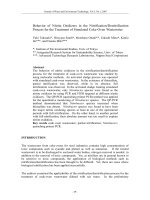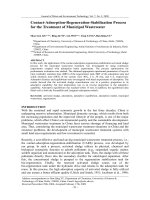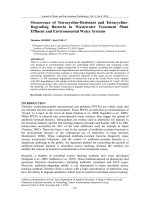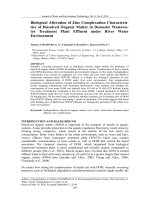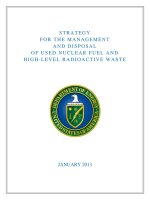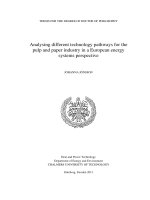Application of Ozone/UV Process for the Reclamation of Sewage Treatment Plant Effluent
Bạn đang xem bản rút gọn của tài liệu. Xem và tải ngay bản đầy đủ của tài liệu tại đây (315.7 KB, 13 trang )
Journal of Water and Environment Technology, Vol.1, No.2, 2003
Application of Ozone/UV Process for the
Reclamation of Sewage Treatment Plant Effluent
Byung Soo Oh, Sei Jun Park, Heung Gu Lee1, Kyoung Suk Kim, and Kyung Hyuk
Lee2, Joon-Wun Kang*
Yonsei University at Wonju campus, Korea
E-mail: , Fax: +82-33-763-5224
1
2
Research and Development Center, Kumho Tire Co. Inc.
Research and Development Center, Samsung Engineering
(* Author to whom correspondence should be addressed.)
Abstract
This study was conducted to evaluate the ozone and UV combination
(ozone/UV) process for the reuse of sewage treatment plant effluent.
The ozone/UV process was compared to the ozone alone and the UV
alone processes by measuring a variety of parameters, such as UV
absorbance at 410 nm (A410), COD, BOD, BOD/COD, TOC, specific
UV absorbance (SUVA), and aldehydes. The organics present in
sewage effluent were more effectively removed by hydroxyl radical
(OH°) than by molecular ozone. The ozone/UV process was highly
effective for the color removal, disinfection, mineralization of
organics, and minimization of ozone by-product. It was also found
that ozone/UV process equipped with high-intensity UV lamp was
more efficient and economical than that with low-intensity UV lamp.
Key words
Ozone/UV Process; Reuse; Hydroxyl Radical (OH°); Mineralization;
Introduction
Ozone is a strong oxidant and disinfectant that is commercially used for water
treatment. In actual practice, however, the direct reaction of ozone is quite
selective in organic oxidation. This is because ozone has a very low reactivity
toward aromatics substituted with electron-withdrawing groups (-COOH, -NO2)
and compounds with single bond (1). Therefore, the advanced oxidation processes
- 141 -
Journal of Water and Environment Technology, Vol.1, No.2, 2003
(AOPs) involving the generation of hydroxyl radicals (OH°) have become the
subject of numerous studies to overcome the limitation of ozone oxidation (2).
The ozone/UV process is an effective technique to enhance OH° generation in
ozone oxidation. This process was developed in the early 1970s for the treatment
of cyanide-containing wastes. Some studies have shown that the process is more
effective for the destruction of some organic compounds than ozonation alone and
that it has significant potential as a water treatment (3, 4). Many authors proposed
that some free radicals such as OH° might play an important role to destroy
compounds that are refractory even to ozonation (5).
In this study, the ozone and UV combination (ozone/UV) process is applied for the
reuse of sewage effluent. Therefore, the aim of this study is to evaluate the
effectiveness of ozone/UV process for the treatment of sewage effluent compared
to the other processes such as ozone alone and UV alone.
Materials and Methods
Raw water characteristics
Sewage effluent water from a sewage treatment plant in W city was used as sample.
The typical water quality characteristics (CODCr, BOD5, TOC, A254 (UV
absorbance at 254nm), pH and alkalinity) of the sample are shown in Table 1.
Table 1. Typical water quality characteristics of sewage effluent.
Parameters
Values
CODCr (mg/L)
15–21
BOD5 (mg/L)
2–6
TOC (mg/L)
5–15
A254 (cm-1)
0.12–0.16
PH
7.5
Alkalinity (mg/L) as CaCO3
153–165
Experimental procedure
The experiments were carried out in a semi-batch reactor (0.5 L and 30 L, with
low- and high-intensity UV lamp, respectively) equipped with a low-pressure Hg
arc lamp (WEDECO, Germany). Ozone was obtained from oxygen through the
ozone generator (OZONIA, USA) and was continuously diffused at a flow rate of
0.5 L/min into the photo reactor. In the 0.5 L reactor, ozone was directly injected
into the UV reactor and was mixed up by the magnetic stirrer. On the other hand,
- 142 -
Journal of Water and Environment Technology, Vol.1, No.2, 2003
the 20 L reactor was composed of the ozone reactor (22 L) and UV reactor (8 L).
The sample was circulated at a flow rate of 30 L/min through the centrifuge pump.
These reactors were both able to operate the ozone alone and UV alone processes.
Figure 1 shows the schematic diagram of the experimental system.
O3 decomposer and
Vent
O3 monitor
O3 generator
UV lamp
(High intensity)
30L reactor
O2
UV lamp
(Low intensity)
Cooling
500mL
reactor
Ozone/UV
reactor
UV
reactor
Ozone
reactor
stirrer
pump
Figure 1. Schematic diagram of the experimental system.
Results and Discussion
Evaluation of several processes: Ozone alone, UV alone, and
Ozone/UV
Color removal: UV absorbance at 410 nm (A410) was used as a parameter for
color measurement (6). Results show that both ozone alone and ozone/UV
processes were significantly effective, showing 80% reduction of A410 after 10 min
of run time. On the other hand, the UV alone process did not show much color
change. Therefore, for color reduction, the ozone alone process was considered as
the best process among the three. However, it should be noted that other
parameters should also be considered in the treatment of sewage effluent water. A
relatively high water quality must be achieved with the end goal of reusing the
sewage effluent water for general household purposes. The color removal
efficiency of each process (ozone alone, UV alone, and ozone/UV) in the sewage
effluent water is compared in Figure 2.
- 143 -
Journal of Water and Environment Technology, Vol.1, No.2, 2003
1.2
Abs(UV410 C/Co)
1
0.8
Ozone alone
Ozone/UV
UV alone
0.6
0.4
0.2
0
0
2
4
6
8
10
12
Time(min)
Figure 2. Degradation of color (A410) by ozone, UV, and ozone/UV processes
(ozone dose rate = 1.6mg/L-min; UV dose = 0.4W/L).
Oxidation of organics in sewage effluent: In Figures 3 (a) and (b), the
removal efficiency of COD and the variation of specific UV absorbance (SUVA),
which can be calculated by dividing A254 with DOC, are compared for the ozone
alone, UV alone, and ozone/UV combination processes. The ozone alone process
was performed at the condition of aqueous pH 4 and 7 to investigate the effect of
different pH in direct ozone and OH° reactions with organic matters. In Figure 3
(a), up to 90% COD was removed by the ozone/UV process and up to 60% and
40% by ozone alone process at pH 7 and 4, respectively. It was also found that the
effect of UV irradiation could be negligible for the COD removal. According to
Hoigné et al., the mechanism of the reaction of ozone with substances in the water
can be divided into two distinct pathways (7). The first route is the direct attack of
molecular ozone. The second route is the indirect reaction of OH° formed by
ozone decomposition. In sewage effluent, the following reaction pathway of
sewage effluent organic matters (EfOMs) of ozone and OH° are to be considered.
EfOMs + O3 → products
[1]
EfOMs + OH° → products
[2]
Ozone oxidation in pH 4 could reflect the direct reaction between the NOMs and
the molecular ozone. At pH 7, NOMs would not only be decomposed by
molecular ozone but also by OH°, which can be formed by the ozone decay.
- 144 -
Journal of Water and Environment Technology, Vol.1, No.2, 2003
Therefore, the difference in the removal efficiency between pH 7 and 3 could be
explained as the effect of OH°. Results show that COD removal in ozone/pH 7
and ozone/UV processes was enhanced up to 20% and 50%, respectively, as
compared to ozone/pH 4. This implies that the AOPs involving OH° production
could be a promising technique for treatment of sewage effluent and the ozone/UV
process could enhance organic removal through more OH° production.
Figure 3 (b) shows the change of SUVA during the treatment of sewage effluent
with each process. This value could provide insights into the characteristics of
natural water such as aromatic contents per unit concentration of organic carbon,
hydrophobicity, and molecular weight distribution of DOC (8). In this research,
the water tested had a relatively low SUVA value (1.1–2.5 L/mg-m), indicating
that the water contained hydrophilic and low-molecular-weight materials. As
shown in Figure 3, SUVA decreased up to 20, 60, 70, and 80% after UV alone,
ozone/pH4, ozone/pH7, and ozone/UV combination processes, respectively. This
means that both ozone alone and ozone/UV processes could alter hydrophobic to
hydrophilic and high-molecular-weight to low-molecular-weight organic matter (8).
1.4
Ozone alone
Ozone/UV
Ozone/pH4
UV alone
COD(C/Co)
1.2
1
0.8
0.6
0.4
0.2
0
0
10
20
Time(min)
(a)
- 145 -
30
40
Journal of Water and Environment Technology, Vol.1, No.2, 2003
1.2
Ozone alone
Ozone/UV
Ozone /pH4
UV alone
1
SUVA
0.8
0.6
0.4
0.2
0
0
10
20
30
40
50
Time(min)
(b)
Figure 3. (a) Degradation of COD; (b) Variation of SUVA value by ozone, UV,
and ozone/UV processes ([COD]o = 15~21 mg/L; [SUVA]o = 1.3~1.5 L/mg-m;
ozone dose rate = 1.6mg/L-min; UV dose = 0.4W/L).
Variation of biodegradability: To compare the biodegradability between ozone
and ozone/UV processes, BOD and BOD/COD values were measured (Figure 4).
In the ozone alone process, BOD increased from 2.2 to 2.5 mg/L at 15 mg/L ozone
dose, after which its value gradually decreased with the increase of ozone dose. In
the ozone/UV process, BOD was rapidly reduced up to 80% with 50 mg/L of
ozone dose. The ratio of BOC/COD value was also compared as a parameter
presenting biodegradability in the water (9). The ozone alone process showed that
the BOD/COD value was approximately 4.5 times higher than its initial value at 15
min after ozonation. However, the ozone/UV process did not cause any significant
change of BOD/COD value during the reaction time. From this result, it was
found that the ozone alone process was not effective in reducing BOD value.
However, it enhanced the biodegradability in the water, giving the possibility of
pre-treatment process for biological treatment. For the ozone/UV process, because
both BOD and COD decreased to low level (0.3 and 0.8 mg/L) and no increase was
observed, the water treated could be directly reused as relatively clean water.
- 146 -
Journal of Water and Environment Technology, Vol.1, No.2, 2003
2.5
Ozone alone
BOD (C/Co)
2
Ozone/UV
1.5
1
0.5
0
0
50
100
150
200
Time(min)
(a)
5
BOD/COD (C/Co)
4.5
4
Ozone alone
Ozone/UV
3.5
3
2.5
2
1.5
1
0.5
0
0
15
Time(min)
30
60
(b)
Figure 4. (a) Variation of BOD; (b) BOD/COD values by ozone and ozone/UV
processes ([BOD]o = 2~3 mg/L; [COD]o = 15-18 mg/L; ozone dose =
2mg/L-min; UV dose = 8 W/L).
Disinfection: The effect of disinfection by ozone, UV, and ozone/UV processes
was investigated by detecting E. coli in the sewage effluent. The concentration of
E. coli was 980~1050 CFU/mL. As shown in Figure 5, 3.6 mg/L of ozone dose
and 0.83 W-min/L of UV dose were required for the 99% inactivation of E. coli.
Results show that both the ozone and the UV were strong disinfectants, and the
OH° formed by ozone/UV process could inactivate E. coli present in sewage
effluent. This indicates that the ozone alone and the UV alone processes could be
sufficiently used for disinfection of sewage effluent. It was also found that the
ozone/UV process showed similar effect for the E. coli inactivation as compared to
- 147 -
Journal of Water and Environment Technology, Vol.1, No.2, 2003
the other processes (ozone and UV alone), and enhancement through OH°
production did not rise for the disinfection.
1200
E.coli (CFU/mL)
1000
800
UV alone
Ozone/UV
Ozone alone
600
400
200
0
0
0.5
1
1.5
2
Time (min)
2.5
3
3.5
Figure 5. Inactivation of E. coli by ozone, UV, and ozone/UV processes
(ozone dose = 3.6mg/L-min; UV dose = 0.4 W/L).
Mineralization of organics by ozone/UV process
TOC removal: TOC value was measured to compare the mineralization of
organics present in sewage effluent (Figure 6). In the ozone alone process, TOC
was degraded by 40% at 60 min after ozonation, after which this value (2.4 mg/L)
remained constantly until the run was finished. In the ozone/UV process, TOC
value was steadily decreased by 90% during the run time, showing prominent
effectiveness for the mineralization of organics. The oxidative effect of UV
irradiation was insignificant, as shown by the 10% removal of TOC. From this
result, it was confirmed that ozonation had a limitation of organic oxidation due to
the selective reaction and the partial oxidation with organics by ozone (1).
Therefore, ozone/UV should be considered for the treatment of sewage effluent
water for reuse because it resulted in low level of organics.
- 148 -
Journal of Water and Environment Technology, Vol.1, No.2, 2003
1.2
1
TOC (C/Co)
0.8
0.6
0.4
Ozone alone
0.2
Ozone/UV
UV alone
0
0
30
60
90
120
150
Time(min)
Figure 6. TOC removal by ozone, UV, and ozone/UV processes
([TOC]o = 5~8 mg/L; ozone dose = 2 mg/L-min; UV dose = 8 W/L).
Formation and reduction of aldehydes: Aldehydes are known as major byproducts produced after ozonation. Of the aldehydes, formaldehyde and
acetaldehyde are mutagenic and carcinogenic for humans (10, 11). Therefore, the
process using ozone is important to investigate the aldehyde trend. The total
concentration of four principal aldehydes—formaldehyde, acetaldehyde, glyoxal,
and methylglyoxal—in sewage effluent was 51 µg/L. Considering the results
plotted in Figure 7, the ozone alone process showed an increase of aldehyde
concentration up to 110 µg/L at 20mg/L ozone dose, after which the concentration
did not go lower than 80 µg/L. In the ozone/UV process, the aldehyde
concentration increased by 90 µg/L at the initial run time and decreased by 28 µg/L
at 15 min. The UV alone process did not have a significant in the aldehyde
concentration. These results indicate that because the ozone alone process has the
side effect of by-products such as aldehydes, applying this process for the reuse of
sewage effluent could be troublesome. From a different standpoint, since
aldehydes can be used as a surrogate of assimilable organic carbon (AOC) (12), the
ozone alone process could be proposed as a pre-treatment for the biological
treatment, like as the result of BOD increase (see figure 4). It should be noted that
the ozone/UV process could be regarded as a safe technique for the reuse of
sewage effluent and that it minimizes the side effect of ozonation.
- 149 -
Journal of Water and Environment Technology, Vol.1, No.2, 2003
120
Aldehydes (㎍/L)
100
80
Ozone alone
Ozone/UV
UV alone
60
40
20
0
0
10
20
30
40
50
Time(min)
Figure 7. Variation of aldehydes by ozone, UV, and ozone/UV processes
([Aldehydes]o = 51 µg/L; ozone dose = 2 mg/L-min; UV dose = 8 W/L).
Effect of UV type in ozone/UV process
The ozone/UV process employed in this study was equipped with two types of UV
lamp, one for low pressure low intensity (0.4 W/L) and the other for low pressure
high intensity (8 W/L). Figure 8 shows the removal efficiency of COD and TOC
by the two types of the ozone/UV process as a function of ozone dose. Both COD
and TOC values were rapidly eliminated with the increase of ozone dose when
high-intensity UV lamp was used in the ozone/UV process. To remove 90% of
COD, the ozone/UV process with high-intensity UV lamp (ozone/UV-HI) required
100 mg/L ozone dose and 40 W-min/L UV dose. On the other hand, for the lowintensity UV lamp (ozone/UV-LI), 780mg/L of ozone dose and 16 W-min/L were
consumed. The difference between the two types of UV lamps was clearly
revealed from the result of TOC removal. The ozone/UV-HI process showed 90%
TOC removal at 300 mg/L ozone dose. However, the reduction of TOC by the
ozone/UV-LI process was merely 23%. The high-intensity UV lamp showed
somewhat higher consumption of electric power than the low-intensity UV lamp.
It could not only greatly lower the amount of ozone dosage, but also significantly
enhance the efficiency of organic removal.
- 150 -
Journal of Water and Environment Technology, Vol.1, No.2, 2003
1
Low intensity (0.4 W/L)
High intensity (8 W/L)
CODCr (C/Co)
0.8
0.6
0.4
0.2
0
0
200
400
600
Ozone dose(mg/L)
800
1000
(a)
1
TOC (C/Co)
0.8
0.6
0.4
Low intensity (0.4 W/L)
High intensity (8W/L)
0.2
0
0
200
400
600
800
1000
Ozone dose(mg/L)
(b)
Figure 8. Comparison of the removal efficiency of (a) COD and (b) TOC by lowand high-intensity lamps in ozone/UV process ([COD]o = 18~21;
[TOC]o = 7~9 mg/L).
Conclusions
For the reuse of sewage effluent, the ozone/UV process showed excellent
effectiveness for several aspects, such as color removal, disinfection,
mineralization of organics, and minimization of ozone by-product (such as
- 151 -
Journal of Water and Environment Technology, Vol.1, No.2, 2003
aldehydes). In addition, the ozone/UV process equipped with high-intensity UV
lamp (8W/L) resulted in 88% reduction in the amount of ozone dosage and the
57% enhancement of organic removal compared to the ozone/UV process with
low-intensity UV lamp (0.4W/L). Because the organics present in sewage effluent
was highly destroyed by OH°, the ozone/UV process was favored to mineralize
organics, showing 90% removal of TOC.
The ozone alone process was effective for color removal but showed a limitation,
which is organic oxidation. Considering the results of the BOD/COD and
aldehydes, the ozone alone process could be proposed as a pre-treatment for the
biological treatment because ozonation was able to enhance the biodegradability in
the water.
For the inactivation of E. coli present in sewage water, the ozone alone and the UV
alone processes showed good efficiency with only 3.6 mg/L ozone dose and 0.83
W-min/L UV dose, respectively. If the aim of the treatment were for disinfection
only, either the ozone alone or the UV alone process would be enough.
Acknowledgement
This research was supported by a grant ( 4-1-1 ) from Sustainable Water Resources
Research Center (SWRRC) of 21st century frontier R&D program through the
Water Reuse Technology Center (WRTC) at Kwangju Institute of Science &
Technology (K-JIST).
References
1. Bruno, L., A.R. David and R. B. Deborah, Ozone in Water Treatment
(Colorado, The United States of America: Lewis Publishers, 1991), p.12.
2. Glaze, W.H., J.W. Kang and D.H. Chapin, “The Chemistry of Water
Treatment Processes Involving Ozone, Hydrogen peroxide, and Ultraviolet
Radiation”, Ozone Sci. Eng. 9(4):335-352 (1987).
3. Peyton, G.R., F.Y. Huang, J.L. Burleson and W.H. Glaze, “Destruction of
Pollutants in Water with Ozone in Combination with Ultraviolet Radiation.
1. General Principles and Oxidation of Tetrachloroethylene”, Environ. Sci.
Technol. 16:448-453 (1982).
4. Glaze, W.H., G.R. Peyton, S. Lin, R.Y. Huang and J.L. Burleson,
“Destruction of Pollutants in Water with Ozone in Combination with
Ultraviolet Radiation. 1. Natural Trihalomethane Precursors”, Environ. Sci.
Technol. 16:454-458 (1982).
5. Prengle, H.W., Jr, “Experimental Rate Constants and Reactor
Considerations for the Destruction of Micropollutants and Trihalomethane
Precursors by Ozone with Ultraviolet Radiation”, Environ. Sci. Technol.
17:743-747 (1983).
- 152 -
Journal of Water and Environment Technology, Vol.1, No.2, 2003
6. Beltran, F.J., J.F. Garcia-Araya, J. Frades, P. Alvarez and O. Fimeno,
“Effects of Single and Combined Ozonation with Hydrogen Peroxide or
UV Radiation on the Chemical Degradation and Biodegradability of
Debittering Table Olive Industrial Wastewaters”, Water Res. 33(3):723732 (1999).
7. Staehelin J. and J. Hoigné, “Decomposition of Ozone in Water: Rate of
Initiation by Hydroxide Ions and Hydrogen Peroxide”, Environ. Sci.
Technol. 16:676-681 (1982).
8. Karanfil, T., M.A. Schlautman, and I. Erdogan, “Survey of DOC and UV
measurement practices with implications for SUVA determination”, Jour.
AWWA. 94(12):68-80 (2002).
9. Alvares, A.B.C., C. Diaper and S.A. Parsons, “Partial oxidation by ozone
to remove recalcitrance from wastewaters – a review”, Environ. Sci.
Technol. 22(4):409-427 (2001).
10. Glaze, W.H., and H. S. Weinberg, Identification and Occurrence of
Ozonation By-products in Drinking Water (Denver, USA: AWWARF,
1993), p8.
11. Schechter, D.S., and P.C. Singer, “Formation of aldehyde during
ozonation”, Ozone Sci. & Eng. 17:53-69 (1995).
12. Kang, J.W. and J.B. Kim, “The formation of assimilable organic carbon
(AOC) in ozonated water and the determination of AOC with acinetobactor
calcoaceticus”, J. KSWQ, May, 69-75 (1995).
- 153 -

